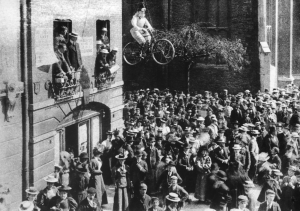By Maggie Pool

In 1897, protests lined the streets at the University of Cambridge to object to a vote that would allow women to attend the all-male university. The crowd launched rockets, threw eggs, and hung a stuffed representation of the “New Woman” from a building, later mutilating it in the streets. The feature acutely defining this “New Woman” was her bicycle.
Globally, the bicycle was a hot commodity in the 1890s. Bikes were cheaper and easier to use than a horse, buggy, or car. For someone making around $10 a week, buying a bicycle was an affordable and easy way to get around. So, how did this affect women?
Before the early 1900s, women’s roles didn’t extend beyond maintaining the domestic sphere. They cooked, cleaned, took care of the children, and generally only left the house when escorted by male, usually by a father or husband. This meant women had no involvement in things like business, politics, and education. However, the bicycle boom allowed women to be themselves without being ignored or easily segregated. With the taste of freedom fresh on their lips, women learned what life was really like outside the home. Thus, a new desire for women’s avocation was born.
Outside the home, the bicycle evolved more than women’s roles. It also revolutionized women’s fashion. Imagine trying to ride a bike outfitted in a corset, bustle, and multi-layer full-length skirts? It didn’t work out so well. Although viewed by many as highly scandalous, bloomers, baggy pants sewed into a big skirt, were the new fashion. For the first time, women were showing off their bare legs.
And, of course, the bicycle allowed quick mobilization for the suffragette movement. Alice Hawkins, a leading English suffragette among the city of Leicester went to prison five times for her acts in the Women’s Social and Political Union campaign. Women’s use of bicycles started with Hawkin’s use her own bicycle. She organized bike clubs that helped spread the word about female emancipation. Being able to travel gave her and other women the ability to do widespread canvassing to get their political point across.
Who would’ve thought that an invention as simple as two turning wheels could’ve liberated women more than anything else before?